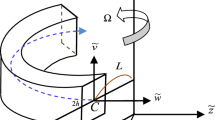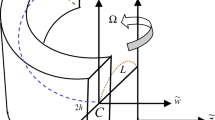Abstract
Conventionally, obtaining a converged solution for a MagnetoHydroDynamic problem entails a highly resolved Hartmann boundary layer, leading to excessive time and computational requirements. For high Hartmann number flows through electrically conducting channels, majority of the current loops close through the walls and the Hartmann layer contributes only a small fraction of the global current path. Hence, the effect on flow parameters due to coarsening the mesh of the Hartmann Layer was investigated using the ANSYS FLUENT code. Numerical simulations have been carried out in square and rectangular ducts with wall conductance ratio of 0.156 and 0.078 respectively. Magnetic field was varied from 1T to 4T to obtain solution for Hartmann numbers \(\left (Ha=Ba\sqrt {\sigma / \mu } \right )\) in the range of 260–1040 for the square duct, and 520–2080 for the rectangular duct. B, a,μ, and σ are the strength of applied magnetic field, characteristic length of the channel, dynamic viscosity and electrical conductivity of the fluid respectively. The errors in estimating core and side layer peak velocity and fully developed pressure gradient were found to be low even for a grid system having 46% coarser grid than a well-resolved system. The analysis indicated that for high Hartmann number flows through thick, conducting ducts, coarsening the mesh in the Hartmann boundary layer reduced computational time, not compromising on the solution accuracy and appears to be a promising option for complex geometry MHD simulation.




Similar content being viewed by others
References
ANSYS FLUENT 13.0 User’s Guide 2010
Davidson P A 2001 An introduction to magnetohydrodynamics. Cambridge University Press
Hunt J C R 1965 Magnetohydrodynamic flow in rectangular ducts. J. Fluid Mech. 21(part 4): 577–590
Muller U and Buhler L 2001 Magnetofluiddynamics in channels and containers. Springer-Verlag
Paritosh Chaudhuri, Rajendra Kumar E, Sircar A, Ranjithkumar S, Chaudhari V, Danani C et al 2012 Status and progress of Indian LLCB test blanket systems for ITER. Fusion Eng. Des. 87: 1009–1013
Patankar S. V 2011 Numerical heat transfer and fluid flow. Taylor & Francis
Sidorenko S I and Shishko A Ya 1991 Variational method of calculation of MHD flows in channels with large aspect ratios and conducting walls. Magnetohydrodynamics 27(4): 437–445
Swain P K, Satyamurthy P, Bhattacharyay R, Patel A, Shishko A, Platacis E, Ziks A, Ivanov S and Despande A V 2013 3D MHD lead–lithium liquid metal flow analysis and experiments in a test-section of multiple rectangular bends at moderate to high Hartmann numbers. Fusion Eng. Des. 88: 2848–2859
Author information
Authors and Affiliations
Corresponding author
Rights and permissions
About this article
Cite this article
SUBRAMANIAN, S., SWAIN, P.K., DESHPANDE, A.V. et al. Effect of Hartmann layer resolution for MHD flow in a straight, conducting duct at high Hartmann numbers. Sadhana 40, 851–861 (2015). https://doi.org/10.1007/s12046-015-0350-1
Received:
Revised:
Accepted:
Published:
Issue Date:
DOI: https://doi.org/10.1007/s12046-015-0350-1




